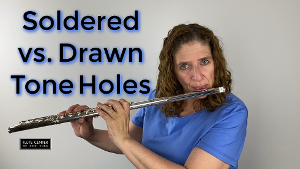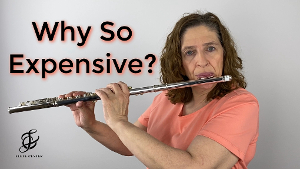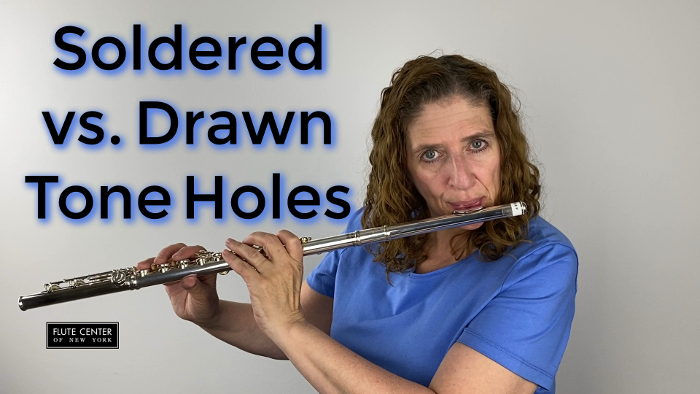Do you know the difference between soldered tone holes and drawn tone holes? Which is better? Which is worse? Or is it just preference?
Well first I did extensive research to learn what the flute makers say. Then I compared two professional model Haynes flutes – one with soldered tone holes, the other with drawn tone holes.
So, I will start by describing what the flute makers say about the difference between tone holes. Then I will tell you what I liked after testing both flutes.
Soldered Tone Holes
On a flute with soldered tone holes, the craftsman makes the tone hole separate from the flute body, and then solders the tone hole onto the flute body. So, some additional metal is used to solder the tone hole right into the hole that has been made in the flute tube.
The introduction of this additional soldering metal may change the sound slightly. Because it vibrates differently. It will have a different resonance. This difference may not be noticeable.
One of the benefits of making the tone hole separately from the flute body is that the tone hole can be made with a nearly perfect shape. This perfect tone hole combined with a technique called “undercutting” allows the key to fit more perfectly flush on top of the tone hole making a tighter seal. This in turn enables the flutist to experience a key that is less likely to leak. We have all experienced the frustration of leaky keys – yes of course that will always happen when the pads wear out. But a more perfectly fitting key & tone hole enables the pads to completely close the keys when our fingers tell them to.
Flute makers claim that soldered tone holes offer:
- More resonance
- More depth of tone
- Better (nearly perfect) intonation
- Darker sound – slightly less brilliant
- Better response
- More powerful dynamic range
- Larger range of colors
Drawn Tone Holes
On a flute with drawn tone holes, the craftsman makes the tone hole out of the flute body. While the metal is hot, they will create the hole and draw up the edges of the hole out of the existing metal of the flute tube. They will then roll down the drawn edges to make a smooth surface for the key to sit on top of it. That is basically a drawn tone hole on a flute.
One of the challenges with drawn tone holes is that sometimes the pads do not sit absolutely flush with the top of the tone hole. That is, the tone hole and the key do not have an absolutely perfect fit. Of course, the craftsmen know how to make the necessary adjustments to achieve a proper fit. This is simply an innate drawback.
Flute makers claim that drawn tone holes offer a brighter tone color.
Are they Better or Worse?
For my comparison I used the same headjoint on both flutes, switching between flute bodies so I could more clearly compare just the tone holes. First, I played the drawn then soldered listening for the differences mentioned by the flute makers. Then I went back and played both a second time moving more quickly from one to the other.
Playing Drawn
The brighter sound with the drawn tone holes was the biggest differentiator. I definitely hear that brighter sound, particularly in the low register. The brightness is just beautiful. It really booms right out. But I feel like I could still control it. It is still a gorgeous sound. It’s just brighter.
It is smooth though. It still has a very smooth tone. It is very resonant. Also, it is very present. It is right there in front of you. I like that tone. I don’t think it’s a bad tone. But it is definitely a brighter tone than perhaps the flute that I normally use.
I think the response is good – just what I would expect from a professional model flute.
Playing Soldered
Well, right away I feel so much more power coming from this instrument than I did with the drawn tone holes. I could definitely hear it. There is power. There is a definite larger sound coming from here.
I feel like I can get a really dark edge on this flute. This is a darker, richer sound.
The finger action on the soldered flute is little bit better. I feel like it’s easier to make it clean. That could be because of the more perfect seal that is achieved with soldered.
I am not positive, but I think I notice a slightly better response from the soldered.
My Preference
Both flutes are gorgeous to look at, felt great in my hands, and produced a nice tone. But for me, I like the darker sound of the soldered tone holes! I found myself playing around with instrument more, because it was really exciting to play. I think it is gorgeous. This sound is what appeals to me. Plus for the way I play, I like the control that I can get from this flute.
It is why I have a 14-karat gold riser in my headjoint. It gives me just a bit of a darker edge, just a little less bright.
I feel like the younger me would have liked the brighter sound better, but the older me likes this darker sound better. So, it depends on what year I was looking for a flute, whether I would pick the drawn or the soldered.
Is Soldered Worth it?
Soldered tone holes come with a price. The 2 professional model Haynes flutes that I tried were identical except for the inline vs. offset G key, and soldered vs. drawn tones holes.
At the time of this writing, the soldered cost about $3,000 USD more than the drawn, depending on the cost of silver, etc. That is an additional 25%.
However, there is a difference between these flutes that goes beyond price. Your opinion about which flute sound you like, and your budget, should be the deciding factors when choosing a flute. In other words, if you have the budget, then it is ultimately about your preference – which sound you like when you play. When possible, the deciding factor should be: do you like your sound on this flute?
So, when you get the chance to try out flutes, listen for which has a brighter tone color, or a darker sound, more resonance, more depth of tone, a better response, more powerful dynamic range, larger range of colors, and more power, etc. But, boil it all down to whether or not you like your sound.
Now you know what to listen for when comparing soldered tone holes to drawn tone holes.
Have fun!
Doctor Flute
Watch me demonstrate this:
Comparing Soldered Tone Holes with Drawn Tone Holes DoctorFlute – FCNY Sponsored

Here are the 2 flutes & 1 headjoint demonstrated:
William S. Haynes Custom Handmade Silver Flute – Soldered Tone Holes
All silver tubing, mechanism, tone holes, rings, ribs, and posts; lightweight pinless mechanism, soldered tone holes, French (open hole) model, pointed style key arms, gold springs, .016” standard wall tubing, inline G key, split-E mechanism, C# trill key, D# roller, and B footjoint. Handmade in USA.
William S. Haynes Custom Handmade Silver Flute – Drawn Tone Holes
All silver tubing, mechanism, tone holes, rings, ribs, and posts; lightweight pinless mechanism, drawn tone holes, French (open hole) model, pointed style key arms, gold springs, .016” standard wall tubing, offset G key, split-E mechanism, C# trill key, D# roller, and B footjoint. Handmade in USA.
https://flutecenter.com/products/haynes-silver
Haynes Silver Handcut Headjoint – Coin Silver Tubing, Silver Lip Plate and riser, .016” standard wall tubing, Piedmont cut headjoint. Handmade in USA.
https://flutecenter.com/collections/customfl-haynes-headjoints
If you’re interested in setting up a flute trial, please consider FCNY and tell them I sent you (Code: DrFlute) to get some extras for free.
To start your flute trial, you’ll first want to go to flutecenter.com and fill out the form. Here’s the link:
https://flutecenter.com/pages/trial-form
Then put my code: “DrFlute” in the box labeled “Influencer Code.”
This code gives you these extras with some exceptions:
*3 extra days to try your flute – that’s a 10-day trial instead of only 7 days
*6 extra months of warranty on your new flute – that’s 18 months instead of only 12 months
*Free Shipping of up to three flutes, piccolos, and/or headjoints at a time for trial!
*10% off sheet music
*Free domestic shipping on instrument purchases
Plus, when you purchase a new flute using my code, FCNY will pay me a small commission. Thank you!
Why Are Professional Flutes So Expensive? Flute Center Sponsored

Should You Put a Professional Headjoint on an Intermediate Body?

Professional Flute Extras – Do You Need Them? FCNY Sponsored

